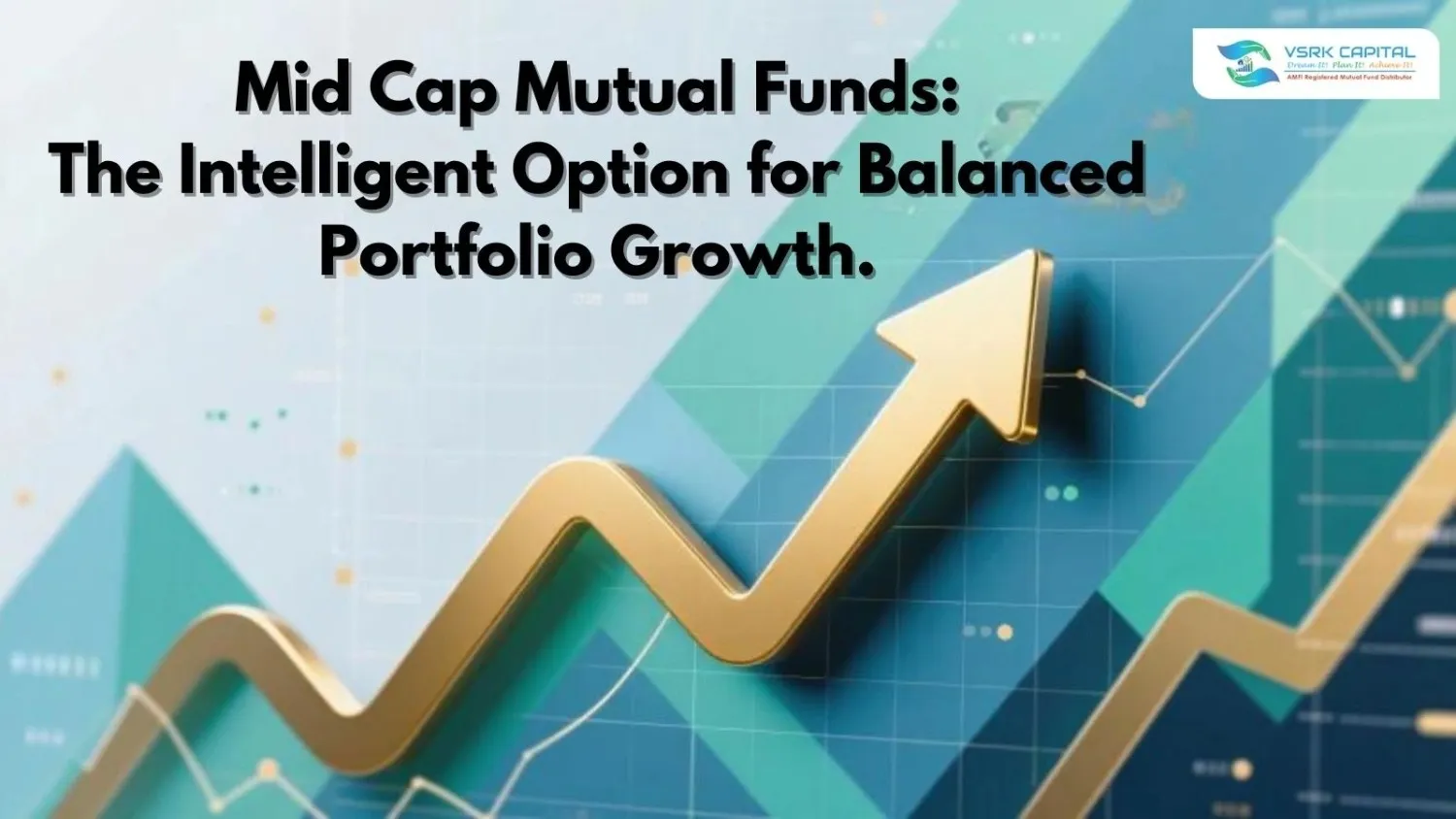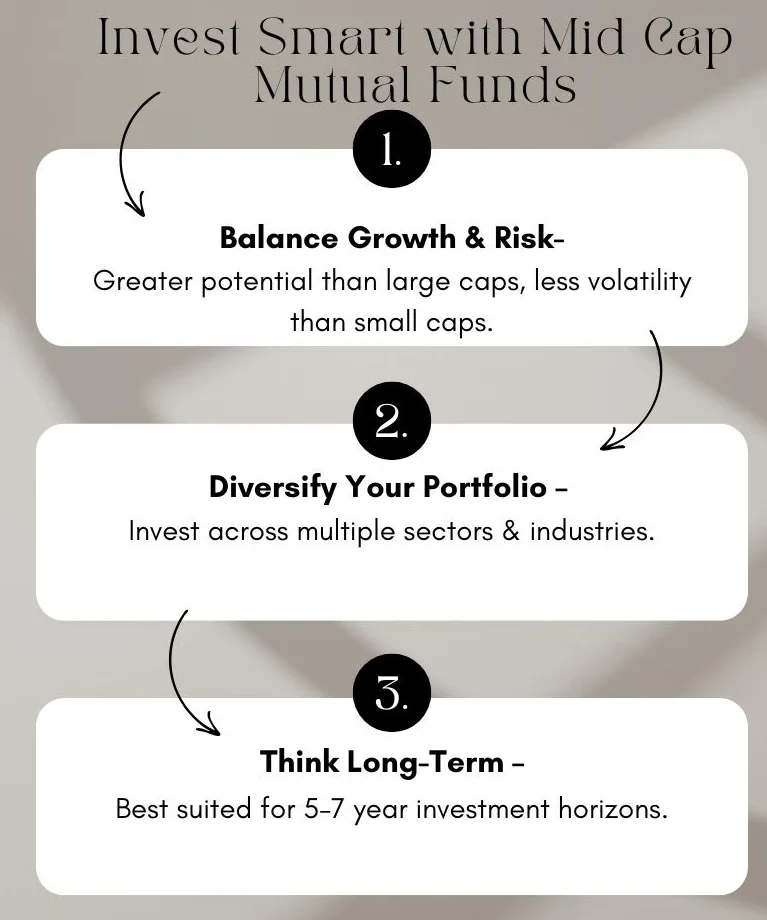Table of Contents
ToggleMid Cap Mutual Fund — If you’re looking for an investment opportunity that offers a balanced risk and return, a mid-cap mutual fund may be the best option. A midcap mutual fund invests in the shares of mid cap companies—companies that are neither as big as large cap companies, nor smaller than small cap companies. They offer growth opportunities that are typically greater than those of large caps, but skip some of the volatility associated with small caps. They do, however, include market risk like all equity mutual fund choices.
Here in this article, we are going to discuss the midcap fund meaning, the multicap fund meaning, how the midcap futures work, why they are suitable for various risk appetites, and how they stack up against extremely high risk mutual funds.
What is a MidCap Mutual Fund?
A midcap mutual fund is a mutual fund scheme that invests a minimum of 65% of its portfolio in mid cap companies. According to SEBI classification, mid caps are companies placed between 101 and 250 in the list of full market capitalization.
Midcap fund meaning: Simply put, it is a fund that tries to harness the potential for growth of mid-cap companies while managing risk and reward more appropriately than small caps.
Why Invest in MidCap Mutual Funds?
The following are some compelling reasons to invest in a midcap mutual fund:
1. Balanced Risk and Reward
They are not as volatile as small cap companies but offer greater growth potential than large cap companies.
2. Diversification
Mid cap funds invest in various sectors, providing investors with exposure to a range of industries and equity related instruments.
3. Compounding Benefits
In the right investment horizon, earnings that are reinvested can compound, resulting in large amounts of wealth creation.
Difference Between Mid Cap and Multicap Funds
Although they have a similar name, the meaning of midcap fund and multicap fund is different in terms of investment spread.
Mid Cap Funds – Invest primarily in mid-cap companies, providing moderate growth potential at slightly higher risk than large cap investments.
Multi Cap Funds – Spread investment across large, mid, and small-cap companies, reconciling growth potential with risk by providing wider market exposure.
Mid Cap Futures and Their Role
Mid cap futures are derivative products that enable investors to bet on the performance of mid cap indices.
They are utilized by traders for:
1. Hedge Against Volatility
Midcap futures assist in portfolio value protection by hedging losses in the case of mid cap stock sudden price fluctuations.
2. Speculate on Price Moves
Traders utilize them for earnings from expected short-term rises or declines in mid cap index prices.
Although these enhance returns, they enhance market risk and might not be appropriate at conservative risk tolerance levels.
Risk Profile of Midcap Mutual Funds
Though mid cap funds invest in high-growth stocks, they are more subject to the economy than large caps. So they are riskier than blue chips but less risky than extremely high risk mutual funds like small-cap or sector funds.
Who Should Invest in a Midcap Mutual Fund?
You can think of this type of fund if:
1. Moderate to High Risk Appetite
Best suited for investors who can bear short-term volatility in anticipation of higher long-term growth.
2. Long Investment Horizon
Optimal for those able to remain invested 5–7 years to weather market cycles and optimize returns.
3. Diversification Beyond Large Caps
Aids the distribution of investments in emerging mid-sized firms, decreasing reliance on large cap performance alone.
Advantages of Investing in Midcap Mutual Funds
1. Higher Growth Potential
Mid-cap firms are usually in their phase of dynamic growth, providing greater growth prospects compared to large caps. This may lead to substantial capital appreciation for long-term investors with medium risk tolerance.
2. Improved Diversification
Midcap mutual funds invest in diversified industry and sector groups, minimizing dependence on one specific market segment. This diversification tends to spread returns and risk in an investor’s portfolio over the long term.
3. Established Business Resilience
Most mid cap businesses have already achieved profitability, efficient operation, and scalability. This established business strength positions them favorably for long-term growth with the right balance of stability and potential future growth.
Mid Cap Mutual Funds vs. Very High Risk Mutual Funds
| Feature | Mid Cap Mutual Fund | Very High Risk Mutual Funds |
|---|---|---|
| Risk Level | Moderate-High | Very High |
| Potential for Returns | High | Very High |
| Volatility | Medium | High |
| Investment Horizon | 5–7 years | 7–10 years+ |
Key Factors Before You Invest
1. Risk Tolerance – Understand your tolerance for the ups and downs of investing. More risk can provide a higher return, but can also lead to greater loss.
2. Fund Manager – Select a fund manager with a solid amount of experience, consistent results, and demonstrated rational approaches to understanding volatility in the market.
3. Performance History – Review past returns versus benchmarks to gauge stability, growth potential, and resilience across different market conditions.
4. Expense Ratio – With lower costs, more of your money is invested, earning interest over time for improved long-term wealth generation.
VSRK Capital – Guiding You to Select an Appropriate Midcap Mutual Fund
At VSRK Capital, a Registered AMFI Mutual Fund Distributor, we assist investors in selecting the appropriate mid cap funds based on:
1. Risk Appetite
We evaluate your tolerance for market fluctuation to recommend a midcap fund that is appropriate for your tolerance level.
2. Investment Goals
Your financial goals influence both your short and long-term needs. We recommend, based on those goals, ensuring that the investment alternative selected is consistent with your goals.
3. Growth Potential
We select mid cap funds with solid fundamentals and potential sectors to enhance your wealth generation prospects.
We also help in diversifying your portfolio, whether you are looking at mid cap futures or wanting to know the multicap fund meaning as far as balanced exposure goes.
Investment Steps for a Mid Cap Mutual Fund through VSRK Capital
1. Define Goals – Make a clear definition of your investment goals to align your mid cap mutual fund selection with long-term financial goals.
2. Know Your Risk – Evaluate your risk-bearing capacity to choose between moderately risky mid caps and extremely high-risk equity funds.
3. Pick the Right Fund – Choose based on historical performance, sector diversification, and long-term growth potential of the portfolio.
4. Apply with Ease – Complete the application; VSRK Capital offers comprehensive guidance for hassle-free investment.
FAQs on Mid Cap Mutual Funds
A midcap fund invests mostly in companies between 101 and 250 in market capitalization, balancing risk and growth opportunity.
A multicap fund invests across all market caps—large, mid, and small—for broader diversification.
They involve higher risk with leverage and should be used with care, ideally by sophisticated investors.
No, they are medium-to-high risk—lower risk than small caps but more volatile than large caps.





